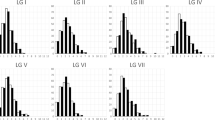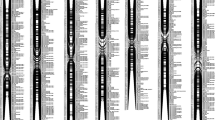Abstract
A genetic linkage map of Pisum sativum L. was constructed based primarily on RAPD markers that were carefully selected for their reproducibility and scored in a population of 139 recombinant inbred lines (RILs). The mapping population was derived from a cross between a protein-rich dry-seed cultivar ‘Térèse’ and an increased branching mutant (K586) obtained from the pea cultivar ‘Torsdag’. The map currently comprises nine linkage groups with two groups comprising only 6 markers (n=7 in pea) and covers 1139 cM. This RAPD-based map has been aligned with the map based on the (JI281×JI399) RILs population that currently includes 355 markers in seven linkage groups covering 1881 cM. The difference in map lengths is discussed. For this alignment 7 RFLPs, 23 RAPD markers, the morphological marker le and the PCR marker corresponding to the gene Uni were used as common markers and scored in both populations.
Similar content being viewed by others
Author information
Authors and Affiliations
Additional information
Received: 13 March 1998 / Accepted: 29 April 1998
Rights and permissions
About this article
Cite this article
Laucou, V., Haurogné, K., Ellis, N. et al. Genetic mapping in pea. 1. RAPD-based genetic linkage map of Pisum sativum. Theor Appl Genet 97, 905–915 (1998). https://doi.org/10.1007/s001220050971
Issue Date:
DOI: https://doi.org/10.1007/s001220050971




